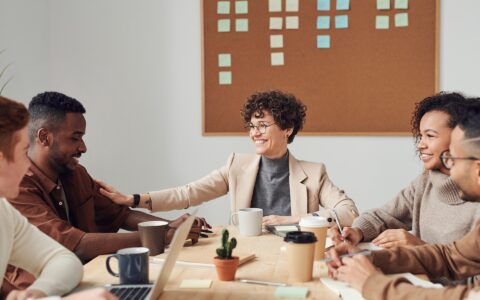Don't have the time to moderate your colleagues' lively discussions and sift through a multitude of ideas during a brainstorming session? Try brainwriting!

Brainwriting can be used de facto every time a brainstorming session could help solve the problem. In general, both methods are used to find answers to questions related to creative activities. You often come across them while working in areas such as marketing, design, art and other creative areas.
During live brainstorming, however, there may be situations when only some team members talk and, thanks to their temperament and commitment, easily delay possible good ideas of others. It is also easy for participants to simply forget their ideas during the performance of their more dynamic colleagues. Some may be afraid to speak up or they are just afraid of being rejected. Thus, even if one of the basic rules of brainstorming, according to which there are no bad ideas, is denied, shyness, for example of new employees, can inadvertently deprive you of interesting ideas.
How Will Participants Influence the Results of Brainstorming?
It is obvious that group dynamics can have an impact not only on the course of brainstorming but also on its results. Less active participants may tend to support the easiest-to-go solutions. While brainstorming can offer you innovative solutions to current problems, its nature also carries certain risks. And the method of brainwriting tries to eliminate them.
Like brainstorming, brainwriting is used to generating ideas and looking for answers to the questions you have asked. Unlike brainstorming, however, brainwriting can effectively involve all of its participants, and as a result often offers more options. The first brainwriting technique was described by German professor Bernd Rohrbach in 1969.
According to Rohrbach the brainwriting session consisted of six participants led by a moderator. Each participant had five minutes to write three ideas. Therefore, this method is also sometimes called 6-3-5. After six rounds, during which participants pass a paper with answers to their neighbors on their right, there are 108 answers, which take 30 minutes to complete.
Three Minutes for Three Questions
Nowadays, however, the rules for brainwriting are less rigid. In general, meeting participants get a sheet of paper on which they write a key question that needs to be resolved but they do not sign it.
Then you decide on a moderator and a time limit for each round. For example, it may take three minutes for all participants to write down their three ideas. Answers should not be further modified or improved. They can be written in any form, even in a witty way. On the contrary, no discussion should be permitted while drafting. It is also possible to say that the first round will last three minutes, but for the following rounds will be shorter, for example only two minutes.
After a defined period of time, participants will pass their written ideas to their neighbor, whose task is to work on three more answers or elaborate colleague’s suggestions. The method of forwarding of responses needs to be clearly defined at the beginning of the meeting in order to avoid undesired confusion. The moderator also determines the necessary number of rounds and their duration.
At the end of the agreed time, the moderator collects papers with all suggestions and rewrites the individual answers on a blackboard or flipchart. The following discussion should bring the best ideas, responding to the original assignment. The methods of evaluating of individual proposals are no different from those designed to select the best suggestions arising from a brainstorming session.
Advantages of Brainwriting and When It Is Suitable to Use
Compared to brainstorming, brainwriting technique has several undoubted advantages. Since there is no discussion during the individual rounds during which participants write their ideas, it is possible to obtain a large number of impulses within a relatively short period of time. And because everyone is equally involved in the process of creation, some quiet or shy members of your team will receive proper attention. Brainwriting is also useful for evaluation of activities of individual departments of your company, where varying answers to the same question will help you understand the mood in the sector.
Moreover, authors do not sign their ideas and the process is largely anonymous, which should have a positive impact on the creative thinking of the participants. This may result in suggestions that the authors would otherwise consider too bold or worry about being accepted by the management. The circulation of the paper with the ideas also allows you to further develop colleagues' suggestions in ways that their authors might not even have thought of.

The Smashing Magazine web portal has made an overview of situations where brainwriting should be chosen:
- When the number of participants is too high:
- If your colleagues tend to be on the quieter side, traditional brainstorming might be intimidating for them.
- If your corporate culture doesn't favor unconventional ideas and your company's leadership is not receptive to suggestions that deviate from their established guidelines.
- If you are pressed by time. Within ten minutes you can gather dozens of responses to your question.
- If you have no experience with brainstorming:
- If you have strong individualities in your team and they could influence others during traditional brainstorming.
Brainwriting can also be used during a conference with several hundred guests. You distribute blank papers, ask the participants write their answer to the question, and after one minute they pass their paper to the neighbor on the designated side. You can repeat the procedure three times. Of course, the number of answers and their quality depends on the audience and their mood, but it is still likely that you will get a good amount of inspiration in just a few minutes.
Conducting a brainstorming session requires some practice as it can easily get out of control. On the other hand, to prepare brainwriting, you just need to formulate the desired question, watch the time and at last collect the paper with answers.
Preferring one method or the other may depend on your time options. Brainwriting should take less time. On the other hand brainstorming should give participants more space to elaborate ideas.
The required degree of interaction between individual participants is also important. Brainwriting will provide everyone with the same space. On the other hand, successful brainstorming cannot do without a proper tension between individual speakers. Therefore, it is appropriate to use both methods from time to time and to decide on their implementation only on the basis of confirmed names of participants and according to the time the discussed issue will consume. We will return to specific options of brainwriting in one of our articles.
Conclusion
Brainwriting offers a compelling alternative to traditional brainstorming, with several key advantages. This method enables active participation from all team members in idea generation, eliminating the need for extensive discussions.
It's crucial to recognize that there's no one-size-fits-all approach for every situation. The decision between brainstorming and brainwriting should be based on your team's specific needs and the task at hand. At times, a combination of both methods may yield the best results.
Regardless of your choice, incorporating brainwriting technique into your process can swiftly generate valuable ideas and inspiration. It's a valuable tool for enhancing creativity within your organization and achieving innovative solutions efficiently.











